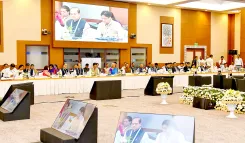Market's Attention Turns to RBI MPC Meeting Post-Budget

Synopsis
Key Takeaways
- Upcoming RBI MPC Meeting: Scheduled for February 7.
- Potential Rate Cut: Anticipated 25bps reduction to boost liquidity.
- Shift in Fiscal Focus: From capex to consumption and savings.
- Fiscal Discipline: Deficit pegged at 4.4% for FY26.
- Stable Subsidies: Remained flat for three years.
New Delhi, Feb 3 (NationPress) The market is set to process the budget announcements while redirecting its attention towards earnings and the upcoming RBI monetary policy committee (MPC) meeting scheduled for February 7, as indicated by a report released on Monday.
The MPC is anticipated to implement a 25bps rate cut aimed at further enhancing market liquidity, based on previous forecasts. This meeting will determine crucial factors such as key interest rates, the Cash Reserve Ratio (CRR), and the Reverse Repo Rate. It will also mark the inaugural policy decision under the new RBI Governor Sanjay Malhotra, making it particularly significant for market sentiment.
The analysis from Motilal Oswal Financial Services Ltd. (MOFSL) suggests that the Union Budget for 2025-26 signifies a shift from capital expenditure (capex) to a focus on consumption and savings, while still emphasizing fiscal deficit consolidation.
Diverging from previous years, the Budget aims to invigorate consumption and savings instead of solely concentrating on capex. Nevertheless, it continues to uphold a commitment to fiscal consolidation.
The Budget has altered its fiscal approach to encourage consumption, moving away from a long-standing emphasis on capex, in response to prevailing consumption weaknesses and subdued economic sentiments.
Finance Minister Nirmala Sitharaman has shown adaptability in modifying the fiscal approach to stimulate consumption without resorting to populist tactics, as noted in the report.
The Budget also preserves fiscal discipline, with the fiscal deficit for FY26 projected at 4.4 percent, which is 10 basis points lower than the glide path requirement.
This is anticipated to positively impact the bond market, bolster India's standing with sovereign rating agencies, and create space for monetary accommodation, potentially enabling the RBI to lower rates.
Subsidies have remained unchanged for the third consecutive year, declining to 8 percent of total expenditure in FY26E from 14 percent in FY23.
The government has also emphasized enhancing the ease of doing business by increasing reliance on self-regulation/self-assessment, pledging to simplify income tax regulations, and reducing compliance burdens across various laws.
The market is poised to absorb the budget announcements and refocus on earnings as it anticipates the upcoming RBI MPC meeting set for February 7.
Expectations for earnings growth have been tempered, with the Nifty PAT projected to increase by 5 percent and 16 percent for FY25 and FY26, respectively. A preference for large-cap stocks over mid-caps and small-caps is evident, with the Nifty trading at 19.9 times on a one-year forward basis, while Nifty Mid-cap and Small-cap are at premiums.









